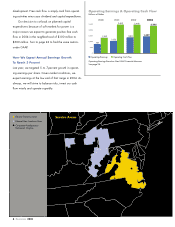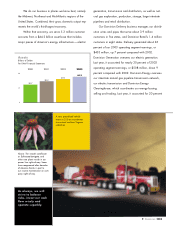Dominion Power 2003 Annual Report Download - page 17
Download and view the complete annual report
Please find page 17 of the 2003 Dominion Power annual report below. You can navigate through the pages in the report by either clicking on the pages listed below, or by using the keyword search tool below to find specific information within the annual report.
customers give us a ready market in which to sell
power or natural gas and to prudently take advantage
of price volatility.
An example is in eastern Pennsylvania, where we
are building a 1,180-megawatt natural gas-fired facility
called Fairless Works. Nearly 200,000 Dominion Retail
customers will be served by output from the first of its two
units, which are both set to come on line in 2004.
Virtually all of the remaining first-unit output is contracted
for sale to a local electric utility.
Internal hedges are simply a more efficient way to
run our business. First, they don’t tie up working capital
the way financial hedges with traders do because they
don’t require cash margin deposits. In addition, internal
hedges increase profits because we cut out the trading
middleman. They also reduce the credit risks of doing
business with others because we deal only with ourselves.
Finally, these transactions don’t require mark-to-market
accounting, which is sometimes required with financial
hedges and may have the potential to distort earnings.
Wise Investing: Adding to our Btu
Balance Sheet Assets
In addition to our construction at Fairless Works, we’re
adding other assets that strengthen our Btu balance sheet.
In 2003, we brought Dominion Cove Point into
operation. Based in southern Maryland, it’s the nation’s
second-largest liquefied natural gas import and storage
facility. It has the capacity to deliver up to 1 billion
cubic feet of natural gas daily — enough to meet the
daily energy needs of 3.4 million homes.
It’s already fully subscribed—by Statoil, Shell and
BP Energy. The first commercial delivery arrived in late
August. The service fees these credit-quality companies
pay add to our earnings. We’re spending $140 million
to expand Cove Point, increasing its LNG tank storage
In addition, internal
hedges increase profits
because we cut out
the trading middleman.
Right: We are constructing a fifth
LNG tank at Cove Point, which
will provide an additional 2.8
Bcf of storage capacity.
Below: Possum Point’s new Unit
6, fueled mainly by natural gas,
will play a significant role in
providing reliable energy while
helping improve the region’s air
quality.
We’re adding other
assets that strengthen
our Btu balance sheet.
























